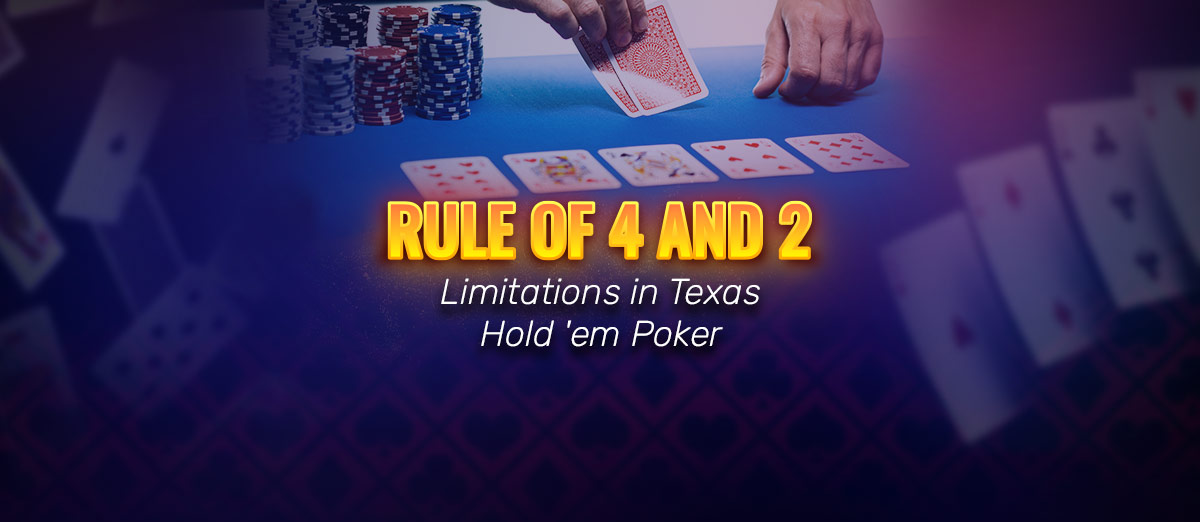Rule of 4 and 2 Limitations – Specifity of this Texas Hold'em Poker Principle

Poker (along with blackjack) is one of the very few games of chance that have had the privilege of being subject to academic research and publications concerning the complexity of their strategies. The complexity of the strategy of Hold 'em Poker lies in the combinatorial nature of the game, the betting rules that allow bluffing, and the multitude and intricacy of the probability fields involved. This latter feature of the game renders the probability computations difficult and the associations between the card odds and certain gaming situations' strategic criteria.
One of the "inventions" of the poker experts related to odds computations in Hold 'em Poker is the so-called "rule of 4 and 2". It was devised as a kind of approximation method that acts as a substitute for exact probability computations that are difficult to execute and apply during the game. In this article, we shall see what the weaknesses of this rule are and when it is accurate and not.
Reasons behind the Creation of the Rule of 4 and 2
From the standpoint of game theory, poker is a symmetric combinatorial game (meaning that no player has any advantage over their opponents, given the rules of the game) with imperfect information (that is, the player knows only their own cards, and the cards the opponents move or base decisions on are not visible). It is also a zero-sum game (a game in which one's gain implies another's loss, and the total value of the game is zero).
Even from this description alone, one can draw the conclusion that poker is hard to master and has a strong mathematical nature, which is why any objective strategy in poker should have a mathematical base. If we just consider probabilities (which are part of any strategy based on either expected value or odds alone), we may fairly rank poker as the card game where card odds are the most difficult to compute and categorize.
In Texas Hold 'em Poker, the probability of an event changes dramatically with every new card dealt, and this contributes to the spectacle of the game: We are dealing with combinatorial probabilities, of which the most relevant are conditional. (This means that the probability of the event in question depends on a previous event whose probability also counts in the equation).
According to these premises, the principle that a successful poker player must master poker math, especially card odds, becomes unquestionable. However, even experts agree that even if such mathematical abilities are attainable, there is no way for them to be applied strategically during the game due to the very limited time in the order of tens of seconds or even less in online poker in which you have to make your decision. This is also the argument of those who say that even if a mathematically optimal game strategy exists in poker, it cannot be actually applied.
The rule of 4 and 2 was thus conceived as a compromise for executing and using precise odds computations: a simple rule at everybody's hand for approximating the card odds during the game.
How this Hold 'em Poker Rule Works
The simplest expectation-based strategy in Hold 'em Poker is the pot odds criterion. (Pot odds are the ratio of the current size of the pot to the cost of a bet or call you have to make to remain in the race to win the pot.) This criterion states that if the pot odds are lower than or equal to your card odds, you should not bet or call because otherwise, this will render negative the expectation of your profit over the long run.
In the jargon of poker strategy, the card odds of hitting your target draw and winning with it are called implied odds. The implied odds were thought to be an indicator for measuring the possibility of improving the expectation given by the pot odds; in other words, it is an indicator used for correcting a strategy based on pot odds by taking into account your opponents' chances of a conditional on your hand and your own hand's chances.
However, an arithmetical formula for calculating implied odds is not given as the probability calculation is difficult. Also, the application of a general formula in the middle of the game is not possible due to the very short time allowed for action. Thus, implied odds are actually a rough estimation of both the probability of you hitting your draw and the opponents beating it conditional on your hit, usually expressed with the degree labels "good" or "bad".
In short, implied odds are a substitute for the exact card odds, given the impossibility of calculation during the game. Yet implied odds involve card odds and, falling within the same approach of approximating and averaging, the poker expert community proposed a rule of giving an approximate estimation of the card probabilities thought to be effective during the game.
Called the "rule of 4 and 2," it works like this:
(1) After the flop, count your outs (unseen cards that are favorable for your target draw) left in the deck for completing your draw.
(2) Multiply the number of outs by 4 and apply the percentage to get the approximate probability of hitting your draw on the turn or on the river.
(3) After the turn, multiply the current number of outs by 2 and apply the percentage to get the approximate probability of hitting your draw on the river. As simple as that!
For instance, for a flush draw with 9 outs in the flop stage, the probability of hitting the flush by the river would be, per the rule of 4 and 2, 9 × 4 % = 36%. In the turn stage, if 9 outs remain, the probability of hitting the flush by the river would be 9 × 2 % = 18%. Let's check against the exact probability: the former is computed as [9 × (47 – 9) + C(9,2)]/C(47,2) = 34.96%, and the latter is 9/46 = 19.56%. Very close, isn't it?
Another version of this rule is the so-called "rule of thumb," which differs from the rule above in that it adds 1 to the product from the turn stage (number of outs × 2 + 1). In this version, the result in our example is even more accurate. So, do such rules really work? Let's check.
Numerical Accuracy and When the Rule Works
Exact probability estimations are impossible in poker during the game, and even though mathematical sources exist listing all probabilities and formulas covering all gaming situations in Hold 'em Poker, it would be impossible to memorize them all for application during the game. The question is whether trained "by eye" estimations and popular approximating rules, such as the rule of 4 and 2, are sufficiently accurate relative to exact probability.
Let's take a few examples:
- Assume the flop cards are (8 A 2), the hole cards (8 7). The target draw that is the most advantageous is a full house of 8s, namely (88877). The probability of this full house being hit by the river is 0.555%. What the rule of 4 and 2 would give for this draw is 5 (outs) × 4 = 20, which is 20% as the estimation, 36 times higher than the exact number. Not that close, right? Taking the target draw to be "any full house of 8s," which has a probability of 1.665%, maintains the inaccuracy: 11 (outs) × 4 = 44.
Let's continue with this example in the turn stage. Assume a 7 was the turn card: (8 A 2 7). The probability for the full house (88877) to be hit by the river is now 7.692%, while the rule of 4 and 2 gives: 2 (outs) × 2 = 4. Taking "any full house" for the target draw (of 8s or 7s), the numbers change as follows: the probability is 15.384%, while the 4-and-2 estimation is 8%. The overestimation in the flop stage turned into an underestimation in the turn stage. - Assume the flop cards are (A 5 8), the hole cards (8 7), and that the target draw is the straight (56789), which has a 1.48% probability. The rule of 4 and 2 gives 8 (outs) × 4 = 32—far enough. Changing the target to "any straight" (56789 or 45678) with a probability of 2.98% means that the error also gets doubled since the 4-and-2 estimation would be 48%.
- Assume the flop cards are (7 J 3), the hole cards (5 7), and that the target draw is "trips of 7s or trips of 5s or better," where "better" means a "full house of 7s or quads of 7s." The probability of that draw is 10.359%, while the rule of 4 and 2 gives: 11 (outs) × 4 = 44, so 44%. Staying only with trips of 7s, which has a probability of 1.665%, the 4-and-2 estimation would be 2 (outs) × 4 = 8—far enough.
Examples such as these may be given in the order of thousands and still prove fairly that the 4-and-2 estimation is numerically inaccurate in most gaming situations. The rule of thumb is also inaccurate, as demonstrated by the above examples. Still, such methods of approximation work in some cases—mostly in the turn stage and in the flop stage for the flush draw, for the quads draw, and, in some situations, for the two-pair draw. In general, they do not work when the draw is a disjunction of several possible draws (of the type "something or better").
Strategic Limitations of the Rule of 4 and 2
Rules of estimation such as the rule of 4 and 2 and the rule of thumb cannot act as substitutes for exact probability estimation and, therefore, in most situations, cannot be taken as a method of indicating the strength of a hand. However, the strength of a hand must be an important factor in an objective strategy.
The implied odds assume a rough estimation of card odds, mostly "by eye" and by approximations designed to bypass an exact probability calculation. We saw that such probability estimations might be tricky and far from the exact numbers. In some situations, the card odds for the player's own hand can be estimated with accuracy with no hard calculations; however, for the opponent's hands, things change dramatically.
It is not the probability that one opponent will achieve a certain hand (or a hand better than your own hand) that is relevant, but that at least one opponent who remained in play will achieve that (as such, a new variable is essentially involved: the number of opponents). The only exact prediction that can be done "by eye" is that a certain draw for the player's own hand is sufficiently disguised so that the opponents cannot guess it.
With the lack of accuracy of the probability calculations for a certain draw, however, expectations cannot be calculated accurately either. Under this premise, the pot odds-implied odds criterion is relevant only as an opportunistic criterion. It is like a bookmaker giving you, say, 10:1 odds on a horse for which you estimate its chances of winning to be, say, 20% (4:1).
The pot odds criterion says that you should take that bet if you are a regular player, but it could also simply tell you that you should take it because it is unlikely that you will have a chance to make such money again or in the near future, regardless of the real odds of winning.
Poker Math and Rules Waiting to Be Proven
Obviously, poker is a game of skill and chance. Skill assumes not only reading your opponents' behavior and strategies and adjusting your personal strategy to their actions but also mastering the odds evaluations. This latter component renders self-study a training requirement outside the game, and the application of this acquired knowledge during the game itself is a skill that assumes quick observation, framing, computing, and recollection.
The number of all possible Hold 'em hands in the flop, turn, and river stages (also taking into account the number of opponents as a parameter along with the board and the player's own hand configuration) is 28,038,455,640, that is, over 28 billion. Each of these hands has a set of probabilities associated with the player's own hand and the opponent's hands for each target draw.
Developing the skill of knowing, categorizing, simplifying, and applying these odds requires far more effort than the skill of reading your opponents long-term. Even though complete sources of exact probabilities for Hold 'em Poker do exist, such a skill may not be attainable for average to expert players simply because a mathematical work dedicated to adequately simplifying the huge "deposit" of card odds with respect to their use in an optimal strategy has yet to be completed by mathematicians.
So, if the popular rule of 4 and 2 fails the test of accuracy with respect to coverage, then what are the options for an experienced player who wants to improve their skills and play while mastering the Hold 'em Poker odds? Poker theorists have yet to say everything there is to say about poker math, but sitting and waiting is not a way of making money or acquiring experience.
One of the important parts of the rule of 4 and 2 is to apply it only in the categories of situations where it has proved accurate. For the other situations, the advice is just to avoid "by eye" probability estimations and try to get the exact numbers from mathematical sources after each poker session, regardless of whether you won.





Review this Blog
Leave a Comment
User Comments
comments for Rule of 4 and 2 Limitations – Specifity of this Texas Hold'em Poker Principle